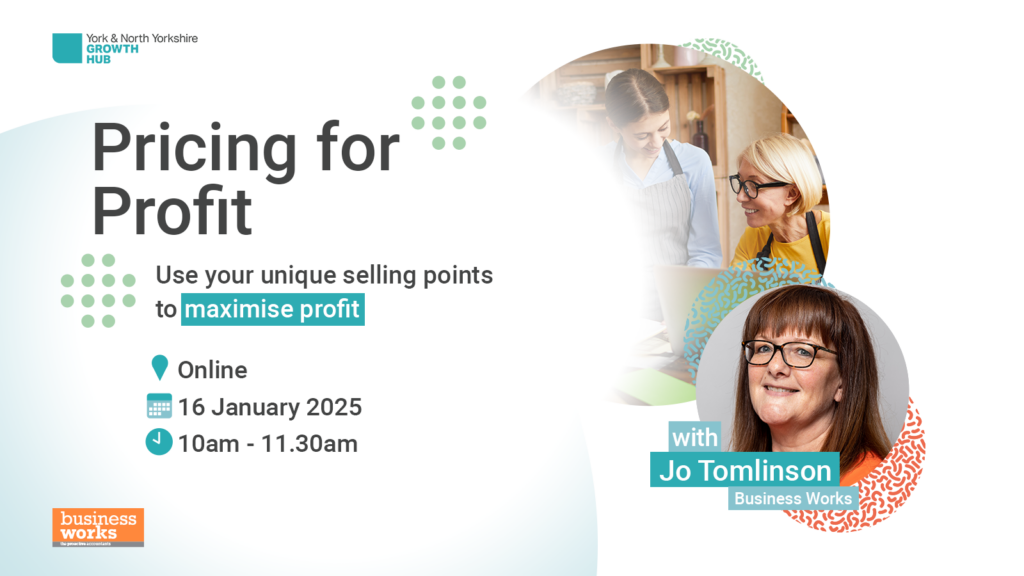Pricing for Maximum Profit
Are you charging enough for your products or services to allow you to provide a service you are proud of and that allows you to not become a busy fool? Are you confident that you are charging the correct price for your goods or services?

The Pricing Mindset
We can often feel pushed into under-pricing our goods and services, and in doing so, undervaluing them and ourselves. But we need to remember that this is our business, and we decide what we charge.
Of course, our customers and clients make their decisions based on what they see, hear, and perceive about our goods or services. So, how can we effectively articulate the value of what we offer in a way that encourages potential buyers to choose us?
And remember, if we don’t charge enough, then we:
- Can’t do a job we are proud of as there won’t be enough time to do so.
- We will end up cutting corners, using substandard ingredients, or quality control.
- If we have a team, we may not be able to afford the right people with the skills and experience to do the job we want them to do, or train them to do so.
We do not want to end up working more hours for less pay, sacrificing family time, or missing out on hobbies and self-care. This just destroys your joy, and eventually, your business.
Why do people pay more for some things, and not for others?
People buy for many reasons other than price. Price is a factor (most of the time, for most people) but it’s only one.
Most people didn’t start their business because of profit or money, but they still need to make a profit to pay their bills. Most people will pay more than they initially intended for something they really want and believe is worth it.
Things we buy are worth more if:
- It’s scarce – supply and demand dictate that we can increase our prices if we don’t have competition or the thing we are selling is in short supply. If you really want it, you will pay more if you have no viable alternative.
- It’s convenient – it’s right here, right now, just where I am, and I don’t want to go searching elsewhere.
- It’s comfortable – fit and comfort are really important.
- Someone else said it was – the first purchase of your goods or services is often based on perception, so if other people are saying it’s worth it, then you may also believe that it is.
- We believe it is – for one of the reasons above, or something else.
- It feels right – there is an element of balance, when it comes to pricing. If something looks too good to be true, then it probably is. So, our price, product and proposition must all be in balance to get the sale.
Charging “More”
If you want to charge more than others in the market you trade in- more than your competitors, then you are going to need to persuade buyers in this marketplace that your “More” is worth “More.”
Your “More” is the thing that sets you apart, the unique ingredient, the design, the quality, then thing that your customers see is being worth “More.” This is often called your Unique Selling Point.
It’s important to do your research into why your customers or clients buy from you and why they come back for repeat purchases, or stay with you if you’re a service provider. You need to use these reasons to persuade new customers that they too would value your proposition.
Not only will knowing why people buy from you help your sales pitch, but it should be used in all your marketing.
If you highlight the most important feature, function, or service that your potential buyer is looking for, they are MUCH less likely to focus on the price. This makes them more likely to pay “more”!
Testing
How do you know if you should increase your prices? How do you know if putting up your prices will positively impact your profit? By doing it and measuring the results!
Warning Signs
There are some warning signs that you might not have noticed that indicate you should put up your prices.
Some of these are:
- You win every deal on price!
Have you ever told someone how much it was going to cost, and they said “yes” really quickly? This is a sign that they thought you were going to say it would cost more, meaning you could have charged more! A lost opportunity to make the profit you deserve!
Realistically, not everyone can afford everything. You should expect some people to say that they can’t afford your prices. For example, lots of people who would love to buy a BMW, but buy a lower priced brand, it’s what they can afford and that’s ok. Similarly, some people would to buy a new car, but may settle for an older model because of budget constraints.
People make choices about how they spend their money. Let’s face it, you can only spend it once!
What we want, is enough people to believe that your product or service is worth the price you quote, for you to make the profit you need.
- Your order book is full!
If you operated an order book system and you have no more availability for some time, then you should put your prices up.
Fewer people may say yes, but that’s fine- you are already turning people away. The jobs you do take on will pay more, meaning you can either earn more profit or work fewer hours and regain some quality of life, balance, self-care, and family time!
- When did you last put up your prices?
If this was more than a year ago, it’s time to raise your prices! Everything has gone up in that time.
People don’t respond well to big price hikes so waiting five years between increases won’t go down well… You’ll have to raise them eventually, so why not do it now?
By setting an expectation of small, regular price increases (e.g. annually), your returning customers will anticipate it, making the adjustment easier and less of a hard sell.
Imagine if you could make a small increase in price that has little or no impact on how many you sell. It would go straight to the bottom line…

Pricing Strategies – using the psychology of pricing to increase your revenue
Upselling – increasing the average value of a sale
- Selling a higher value model
- Selling more frequently
- Selling additional products or services while the customer is buying
Offers – only to be used on your terms
- If you are relaunching and want to offload old packaging or products
- If you have certain days, times of the year, or periods during the day when business is slow
- Never do a BOGOFF (Buy One Get One Free) – always get at least something for the additional item you are selling
- Bulk discounts; These can be useful, but ensure you are set up to provide products or services in this way
Bundle pricing
Airlines are the gold standard for bundle pricing. When they advertise the price of a flight, you’re essentially just paying for a seat. They then charge extra for:
- Certain seats – (e.g. near the doors)
- Extra leg room
- Pre-booking seats, to sit together
- Boarding priority (who gets on and off first)
- Baggage
- Food and drink
- Insurance
- Parking
- Hire cars
- And more…
Insurance Companies operate similarly. They provide a basic price on comparison sites, and you can add extra such as:
- No claims protection
- Business use
- Additional drivers
- Breakdown cover
- Legal cover
Mid-Tier Pricing
This strategy is everywhere once you know what to look for, and it’s a fantastic tool. If you start with the gold-standard offer, and get a negative reaction, you can reduce the package to silver, or bronze.
- Having a higher, middle and lower-tier pricing allows people to say yes while sticking to their budget
- You win more sales, AND
- Sometimes you’ll sell the top tier package.
- The middle tier will generally outsell the other two
Value Pricing
This involves working out the value of what you’re selling and pricing it base on its value, NOT the cost of producing it. To do this effectively, you must research what your customers truly value.
- Speed of delivery Paying extra for next-day delivery is common, but think about other services. For instance, getting accounts done quickly for a mortgage application or having computers repaired urgently to minimise downtime
- Gift wrapping: Adding convenience for customers.
- Meeting location: If your time is precious, charge extra for meetings held in your office instead of traveling elsewhere
- Who delivers the service: A named senior person may justify a higher price compared to a competent team member
Scope Creep
This is where service providers can avoid losing a lot of money by not doing free work.
Do you ever have a client say, “Can you just,” or “whilst you are there,” or “it will only take you a minute”? Well, those phrases can be very costly to service providers!
You may, of course choose to just help out, “just this once” and not charge, and that is entirely up to you, this is your business and your customer relationship. However, I would advise tempering this with a response along the lines of:
“Of course, I can help. Our normal charge for this service would be £XX. However, on this one occasion I will do it free of charge, as you are a valued customer of ours. If you do need more of these services in the future, I will have to charge the next time.”
We are rarely just selling time. As service providers, we are often selling a combination of time, experience, and possibly training or qualifications. Additionally, we may be looking to recover the cost of software that helps the process or expensive equipment required to do the job. It is important to remember this and avoid devaluing what we do.
Examples of scope creep
- You are fitting a new kitchen for a customer, and they ask for a couple of double sockets to be fitted that were not part of the original order.
- Your client has agreed to meetings at your location, but is now pushed for time and wants you to travel to them instead.
- Your client is doing their own VAT return but has run out of time and wonders if you can “just sort it” for them, as it will “only take you a minute.”
- The website you are designing is now on its 8th revision.
A process to reduce and possibly eliminate scope creep
Set expectations, from the outset.
- Agree upfront, in writing, what is included and what is not included in the price you have quoted.
- If additional work is requested, send over an additional proposal or quote covering the extra fee, and ensure they sign to confirm their agreement.
Benefits:
- This ensures you get paid for the extra work
- It stops clients from expecting loads of extras for free
- It establishes that additional work is acceptable, but not free
When do you charge?
As soon as possible, especially in a difficult economic climate, make sure payments are secured. If a client goes under owing you money, they could take you down with them.
Suggested Payment Terms
- When they take the goods away they: You wouldn’t expect to take your shopping from Tesco without paying first, so why should this be different?
- On acceptance of the proposal: Clients shouldn’t place an order without the ability to pay! However, if this is a new relationship, they may want assurance that you will provide the goods or services to the agreed quality and timeline. In this case, consider a deposit on acceptance.
- For recurring services: Use direct debit. This allows for varying amounts each month, and you’ll be notified by the provider if any payments fail.
Remember
If they don’t pay, its either a gift or theft. Always be prepared to take legal action if necessary. Keep proof and evidence of all agreements and transactions to support your claim.
This is your business, so you decide on what prices and terms are fair to you. If your customers also find these terms fair, you’ve struck a winning balance.
Sign up to our FREE webinar; Pricing for Maximum Profit happening on 16 January, 10am-11:30am
Pricing for Maximum Profit
Are you charging enough for your products or services to allow you to provide a service you are proud of and that allows you to not become a busy fool? Are you confident that you are charging the correct price for your goods or services?


